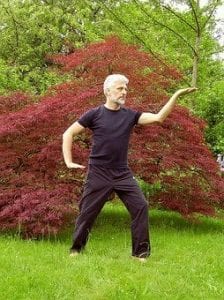Written by Harold Oster, MD. Results suggest that tai chi is more effective than aerobic exercise in reducing systolic blood pressure in adults with prehypertension.
 Hypertension is a leading risk factor for cardiovascular disease and stroke. Compared to normotensive individuals, those with prehypertension, defined as a systolic blood pressure (SBP) between 120 and 139 or a diastolic blood pressure (DBP) between 80 and 89, are more likely to develop hypertension and cardiovascular disease. Aerobic exercise is recommended to lower blood pressure in people with hypertension and prehypertension1. Tai Chi, a low-intensity exercise of controlled, slow movements, has also been shown to lower blood pressure in such patients1,2.
Hypertension is a leading risk factor for cardiovascular disease and stroke. Compared to normotensive individuals, those with prehypertension, defined as a systolic blood pressure (SBP) between 120 and 139 or a diastolic blood pressure (DBP) between 80 and 89, are more likely to develop hypertension and cardiovascular disease. Aerobic exercise is recommended to lower blood pressure in people with hypertension and prehypertension1. Tai Chi, a low-intensity exercise of controlled, slow movements, has also been shown to lower blood pressure in such patients1,2.
Xinye Li et al. studied the effectiveness of tai chi compared to aerobic exercise in reducing blood pressure in adults with prehypertension. Participants with prehypertension between the ages of eighteen and sixty-five were recruited from two hospitals in Beijing, China. The patients were randomized to participate in tai chi or aerobic exercise four times weekly for twelve months. The tai chi was Yang-style, consisting of twenty-four movements3. The aerobic exercise included jogging, brisk walking, cycling, or climbing stairs. Each group performed the exercises for forty minutes with a ten-minute warmup and ten-minute cool-down activity. Blood pressure was evaluated in an office setting at baseline, six, and twelve months. Twenty-four-hour ambulatory blood pressure was monitored at baseline and twelve months. Patients were tested for lipids, glucose, hemoglobin A1c, body mass index, and the Systematic Coronary Risk Evaluation (SCORE), a validated measure of the risk of heart disease4. Other assessments included mean caloric intake and total physical activity over seven days.
The authors noted the following:
- Based on inclusion criteria, 283 participants completed the study.
- At six months, the mean office SBP dropped more in the tai chi group than in the aerobic exercise group. (6.18 mm Hg vs 3.88 mm Hg)
- At twelve months, the mean office SBP dropped more in the tai chi group than in the aerobic exercise group. (7.01 mm Hg vs. 4.61 mm Hg)
- At six and twelve months, office DBP in the two groups decreased to a similar extent compared to baseline.
- Participants in the tai chi group had a lower risk of developing hypertension than those in the exercise group. (12% vs 17.7%)
- At twelve months, mean 24-hour ambulatory SBP decreased more in the tai chi group than in the exercise group. (3.20 mm Hg vs 1.04 mm Hg)
- After twelve months, nighttime ambulatory SBP decreased more in the tai chi group than in the exercise group. (3.45 mm Hg vs an increase of 0.63 mm Hg)
- After 12 months, ambulatory DBP decreased to a similar extent in the two groups.
- There were no significant differences in caloric intake, overall physical activity, body mass index, or SCORE results between the two groups.
Results suggest that tai chi was more effective than aerobic exercise in lowering systolic blood pressure in adults with prehypertension.
Source: Li, Xinye, Peifen Chang, Min Wu, Yuchen Jiang, Yonghong Gao, Hengwen Chen, Liyuan Tao et al. “Effect of Tai Chi vs Aerobic Exercise on Blood Pressure in Patients With Prehypertension: A Randomized Clinical Trial.” JAMA Network Open 7, no. 2 (2024): e2354937-e2354937.
This is an open access article distributed under the terms of the CC-BY License.
Click here to read the full text study.
Posted March 6, 2024.
Harold Oster, MD graduated from medical school in Miami, Florida in 1992 and moved to Minnesota in 2004. After more than 25 years of practicing Internal Medicine, he recently retired. Dr. Oster is especially interested in nutrition, weight management, and disease prevention. Visit his website at haroldoster.com.
References:
- Fu J, Liu Y, Zhang L, et al. Nonpharmacologic Interventions for Reducing Blood Pressure in Adults With Prehypertension to Established Hypertension. J Am Heart Assoc. Oct 20 2020;9(19):e016804. doi:10.1161/jaha.120.016804
- Tam HL, Leung LYL, Chan ASW. Effectiveness of Tai Chi in Patients With Hypertension: An Overview of Meta-analyses. J Cardiovasc Nurs. Sep-Oct 01 2023;38(5):443-453. doi:10.1097/jcn.0000000000000921
- Chen KM, Hsu YC, Chen WT, Tseng HF. Well-being of institutionalized elders after Yang-style Tai Chi practice. J Clin Nurs. May 2007;16(5):845-52. doi:10.1111/j.1365-2702.2006.01448.x
- Graham IM, Di Angelantonio E, Visseren F, et al. Systematic Coronary Risk Evaluation (SCORE): JACC Focus Seminar 4/8. J Am Coll Cardiol. Jun 22 2021;77(24):3046-3057. doi:10.1016/j.jacc.2021.04.052
